In what seems to be an increasingly serious problem for online retailers, the average shopping cart abandonment rate has been bumping up against the 90% level as of late.
Whether or not this rising trend continues is anyone’s guess but with even the 6-month average hovering just under 80%, there is no questioning that it’s a serious issue. If you have any doubts whether this applies to your eCommerce store, rest assured, it probably does.
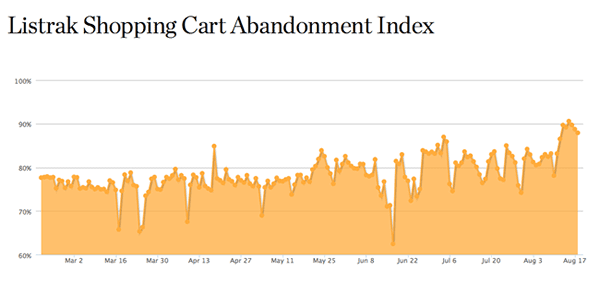
Abandoned Cart Stats from Listrak
While there are many different ways that you can go about reducing your long-term abandonment rate, such as being upfront about shipping costs, providing testimonials and making sure your checkout process is as easy to navigate as possible, our primary focus today will be perfecting the art of abandoned cart emails.
Let start by taking a closer look at how big this challenge really is.
The Challenge of Abandoned Carts
Abandoned shopping carts are a big deal. Really big. Business Insider reported back in March of 2015 that the approximate dollar value of abandoned carts is approximately 4 trillion dollars worth of merchandise each year.
For a small eCommerce merchant running a Divi and WooCommerce powered WordPress online shop, this is a tough statistic to wrap your head around. It’s that big. But let’s scale it down to size and hopefully make those statistics seem a little more relevant.
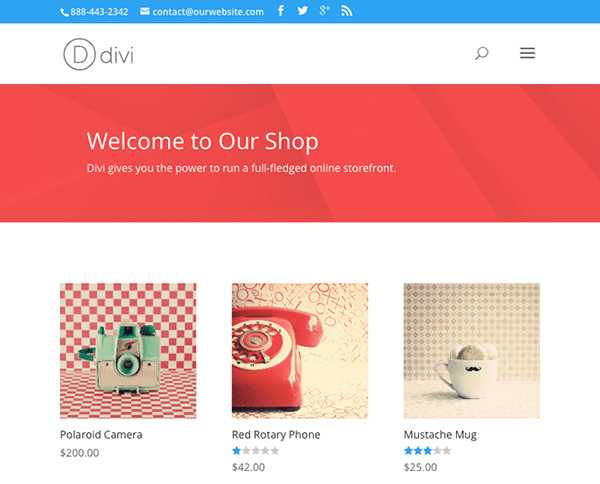
eCommerce Store built with Divi
If you’re running a small eCommerce shop and you’re experiencing any cart abandonment at all, it’s certainly worth your time and effort to start looking for ways to improve the current rate of abandonment on your site. If you percentages are running close to the industry averages, then you actually have a huge opportunity sitting in front of you.
To make the argument of the glass being half full opposed to half empty, we can come at this issue as more of a challenge than a problem. Let’s say you’re faced with the following on an average day:
- You have 10 visitors get to the checkout phase.
- The average order size is $200.
- You average 2 sales per day year round which works out to $146,000/year.
- 8 customers abandon their shopping carts per day (on average).
It’s probably not realistic to think you can convert all 8 of those abandoned shopping carts – that would represent $584k in revenue. Even the 63% recoverable statistic reported by Business Insider seems a little far-fetched to most people. But what about recovering just one abandoned cart – a mere 12.5% recovery rate. How would that affect your store revenues?
Well, let’s imagine you offered a 15% discount on the abandoned cart, putting a value of $170 on that particular order. At one order per day that translates to just over $62k in annual revenue – a whopping 42% increase.
A 42% increase in revenue even makes a 12.5% recovery rate seem unrealistic, doesn’t it? You’d probably be happy with a single-digit revenue increase. Even that would be worth the initial time and effort.
You can see why many people look at this as an opportunity worth investigating – making abandoned cart emails a tactic worth implementing.
We can start our investigation by learning a little more about our customers and their patterns.
Why Customers Abandon Carts
Figuring out why customers abandon their carts can take a little detective work. Although you should always be experimenting and looking for ways to improve your eCommerce website, you have to start with an educated guess. Luckily, there is a ton of data you can consider in order to get the process started. Let’s look at some of the top reasons:
Shipping or Unexpected Costs: 56%
If you’ve ever ordered anything online (of course you have!) shipping costs can be a bit of a shock. On lower priced items, it can add as much as 40%-50% to the total cost. That’s the kind of price jump that can make customers think twice about their purchase. At the very least, they’re likely to consider the potential savings from buying locally.
Found a Better Price Elsewhere: 36%
What makes shopping on the internet so great can also be your biggest enemy. With just a few clicks, shoppers can compare your prices against potentially dozens of competitors. Keep in mind, though, that not everyone makes a purchase based on price alone. It’s almost never a good idea to compete solely on price – the race to zero is a losing proposition.
The Overall Price Was Too Expensive: 32%
As long as your prices are not out of line, sometimes you just have to accept that some people will find the price to be expensive. Like I mentioned above, it’s not always worth competing on price. Decide on an acceptable margin and stick to your guns.
Poor User Experience: 25%
Presenting a shopper with a poor U/X can have a dramatic effect on your abandoned cart rate. In fact, looking at the statistics reported by Statista, there were four double-digit reasons related to user experience. With numbers like that, it goes without saying that, fast page load times, a simple checkout process and reliable hosting are a must when it comes to eCommerce.
Concerns About Payment Security: 17%
This is a problem that swings in both directions. Some shoppers are concerned about not enough security while others are bothered by too many security checks. The first thing to pay attention to here is making sure your customers understand the security measures you have in place. Second, make sure the checkout process is not over-complicated. Some payment processors will allow you to adjust the security checks – requiring just a CVV number or a CVV plus billing address. Look at your payment decline rate and make adjustments where required.
What You Can Do About Abandoned Carts
While there are many options for lowering your abandoned cart rate, our focus today is on using email as a strategy to recover as many sales as possible. Of course, not every abandoned shopping cart can be recovered. You’re really only after the ones where there is a problem that you can rectify. Of the reasons discussed above, your top concerns might be:
- Shipping or unexpected costs
- A more competitive price found somewhere else
- Concerns about payment security
- The potential for a poor user experience
In a perfect world, it would be nice if we could tailor each email that a customer receives to their exact reason for abandoning their cart. While solutions like this are available, they don’t necessarily come cheap. For most small eCommerce merchants, the emails will need to be a little more generic in nature – but that doesn’t necessarily translate to ineffective. Just being proactive will put you ahead of the game.
If your eCommerce platform consists of Divi and WooCommerce, there are still some great options available, such as the Abandoned Cart Pro plugin that let you create an unlimited number of email templates which can be sent out to customers at predefined intervals.
Abandoned Cart Email Content and Timing
While much of the information about the content and timing of abandoned cart emails is subjective, there are lots of guidelines and great examples to help you get started.
Subject Lines
Subject lines are a hot topic and there are plenty of opinions on the best way to start your emails. Across all fronts, it seems to be agreed upon that it’s important to be honest and upfront about the content of the email. But that doesn’t mean you can’t be creative. Some ideas to consider:
- “Based on your recent visit we thought you might be interested in these items:”
- “You’re just one step away from…”
- “Don’t be late, your 20% discount ends soon”
- “Last chance: 60% off for spring finals”
- “It appears you’ve left something behind”
Another interesting point to consider is that email open rates are typically higher when they come from a real person instead of a company. Andrew Youderian at eCommerceFuel discovered a significant uplift in recovered carts when emails came from their sales manager instead of their company. Even if the results were short lived, it demonstrated an increase in curiosity when people perceive a real person to be involved.
Email Content
The balancing act required here involves trying to help your customer to complete their purchase without becoming annoying or appearing pushy. Typically, 3-5 emails seem to be the standard. Smileycookie.com, for example, created a campaign that consisted of three emails.
The first email took a customer service approach, which is quite common. Make the assumption that something went wrong during the checkout process and their customer was unable to complete their order – an attempt to be helpful.
Their second email used a similar customer service tone but also included a coupon good for a 10% discount and provided no specific links to customer service. Their third and final email bumped up the discount to 20% but provided little extra information.
Other companies like Grammarly take a similar approach to customers who sign up for their free service but decline the paid service. Instead of offering a discount upfront, Grammarly sends out well-timed discount offers that coincide with specific times of the year, like back to school or final exams.
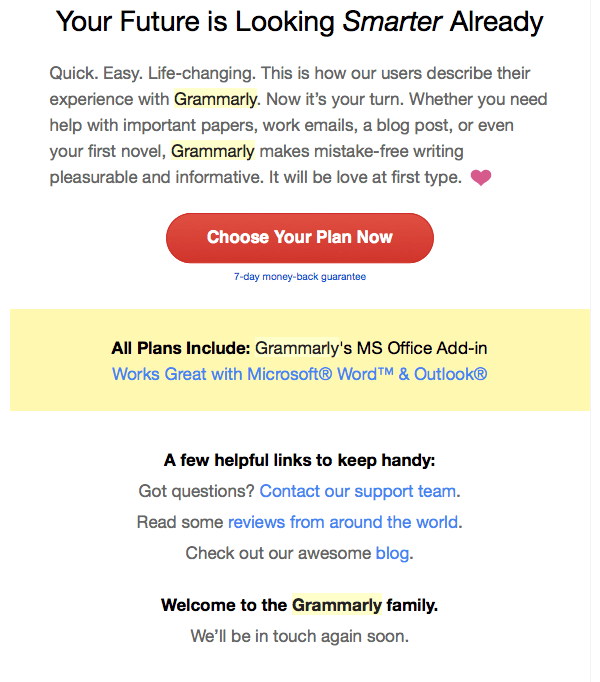
Grammarly Abandoned Cart Email
The exact content that should be included in your emails is open to experimentation, but one thing you should avoid is a hard-sell approach. Instead be helpful and try to direct your customer back into the sales funnel. Try to address their potential questions and concerns.
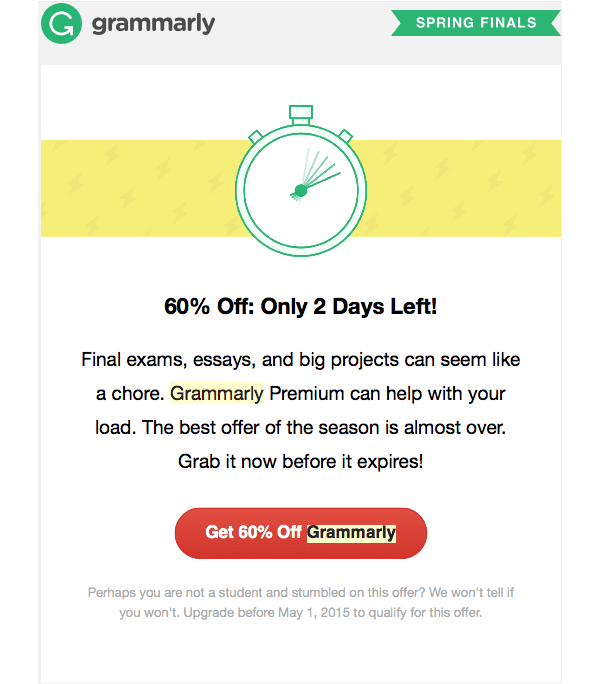
Follow-up Grammarly Abandoned Cart Email
On thing to consider, especially when you don’t know the exact reason why a cart was abandoned, is to make sure you cover all your bases. Don’t send an email that focuses only on the customer service aspect when the price could have been an issue. At the same time don’t assume that price is the primary issue when there could be concerns about making secure payments.
Zappos covers multiple angles with their initial abandoned cart email which is sent approximately 24 hours after leave your cart. In their email they use humor, mention their great return policy, free shipping, customer service details and lead you back to your card with a single click.
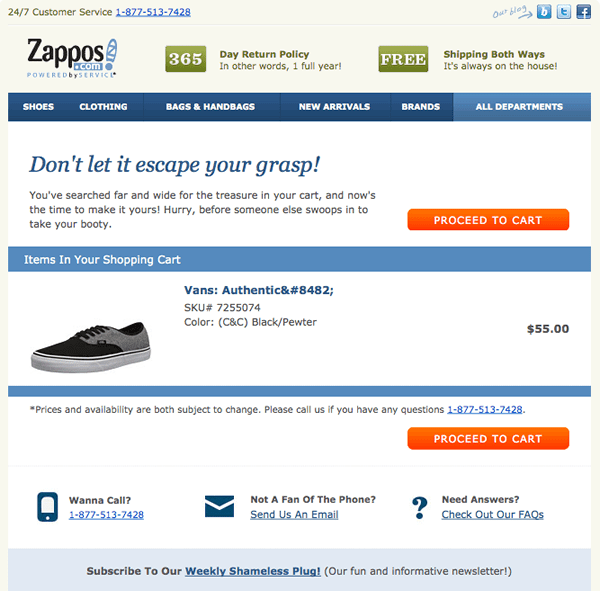
Zappos Abandoned Cart Email
Email Frequency
Frequency, like the content and headlines, deserves a degree of experimentation. There is no such thing as perfect timing and there are many different factors to consider including:
- What are you selling?
- How long is the sales cycle?
- Is there significant price competition?
If you had to pick a good starting point, the first email can usually be sent out within 60-75 minutes after a customer abandons their cart. The second email could be sent 24 hours later followed up by a third email 3-5 days later.
Cart recovery decreases over time, but that doesn’t mean you should abandon all efforts. Developing a long-term email marketing strategy might be one of the best decisions you can make.
Wrap Up
We’ve covered quite a few great reasons to consider implementing abandoned shopping cart emails into your eCommerce strategy. As much as it appears to be a giant problem, it actually presents an easy way to boost your revenues without too much extra effort.
One one the most challenging things to do is convince people to visit your store. Since you’ve already accomplished that, you’re halfway to closing the sale. If you can manage to convert just a small percentage of the abandoned carts you’ll see an impressive jump in revenues.
The most important thing to remember regarding the timing, subject and content of your emails is to experiment. What works for one eCommerce store might not work as well for another.
If you’re using Divi and WooCommerce to power your online empire, what kind of results have you experienced with abandoned cart emails? Please share your thoughts in the comments below.
Article thumbnail image by eatcute / shutterstock.com









Hello,
It’s a good article but what can you do if you don’t know the user ? If he still did not enter his informations (especially email address) ?
Thanks
How to send new order emails to multi vendors by categories products wise in opencart
Good article but can you follow it up with a solid look into the various plugin options out there?
Thanks Dan, I did write these posts a while back:
http://www.wpmayor.com/woocommerce-abandon-cart-pro-review/
http://www.wpexplorer.com/wordpress-abandoned-cart-plugins/
Hope they help, but happy to write about them in more depth here if there is demand?
Thanks for this good information and tools for recovering abandoned shopping carts. I have not been paying attention to this. I will be watchful now. Personally, I abandon shopping carts often to see if I can get a discount. 🙂
A vendor rang the next day to remind me I didn’t finish my purchase. It encouraged me to buy it too. If I remember right, I was in two minds the night before. 50/50. So I didn’t mind if I bought it or not. I was as happy to buy it once she’d called as much as I was content not to return if she hadn’t. She suggested payment over the phone as well. It was an electronic product and I’m now glad she called.
Being an eCommerce web dev, we experience on average 15%-20% across the 80 sites we manage. Sometimes when I tell a potential client about the abandoned cart service they sometimes say what Christina and Sue said. But the reality is if 15-20% are coming back to convert, as a business owner don’t let your bias hurt your bottom line. <—- That is directed to eCommerce businesses who might think it's creepy.
Great job Joe on your post. We have a service http://epicflowers.com/real-time-marketing/ that does more than abandon cart recoveries and I call it real time trigger marketing if you're ever interested.
Just a friendly reminder that in some countries like Germany for example, such mails are illegal if the customer did not agree to receive commercial e-mails from you.
Thanks for that. Well worth knowing.
If you want to read about it (in German): http://m.heise.de/ix/meldung/E-Commerce-Wettbewerbszentrale-stuft-Warenkorb-Erinnerungen-als-unzulaessig-ein-2526842.html
The main reason I abandon carts is because I load them to find out two things. Shipping costs and if there is any VAT (Tax) going to be added. If the site is clear on this before checkout then there would be no need to go through the loading of the cart.
Hope you follow that.
Good point.
Some abandon cart plugins allow you to automatically add a discount coupon to the reminder email that discounts the shipping or tax cost.
I’m sorry, but it would totally freak me out if I received an email as to why I abandoned the cart.
If I have a specific issue I will let the site owner know.
I have to agree with Christina – getting an email about an abandoned cart is just so creepy.
The only reason I abandon shopping is shipping costs. These are always hidden and you can’t tell how much it’s all going to cost until you work through the cart. So my advice is – don’t assume all your customers are from one country.
Great article! I wanted to add another suggestion for increasing the conversion rate of completed sales: PayPal. I know that sometimes, I’m just curious about a product, go to a site to check it out, decide I like it, but when it comes to paying for it, I don’t have my credit card info handy, so it makes me reconsider whether I really need the item, and 9/10 times I decide it was an impulse buy and change my mind. Now, add PayPal as an option. There is now no need to pause my checkout process to find my credit card number, and I simply proceed to buy the item. I’m happy. Seller is happy.
Good idea!
Poor user experience is the reason why I abandoned my shopping cart in one site where I was about to buy a wordpress plugin.
Thanks Joe! Any thoughts on really good abandoned cart plugins for WooCommerce? 🙂
Hi Leo,
I’ve used the one from Tyche Softwares in the past and it worked really well.
Cheers,
Joe
Thanks Joe! Any thoughts on really good abandoned cart plugins for WooCommerce? 🙂
Hi Leo,
I’ve used the one from Tyche Softwares in the past and it worked really well.
Thanks,
Joe